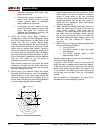
Ridge Tool Company Elyria, Ohio U.S.A www.seektech.com 21
SeekTech SR-60
In general, directly connected Active Line Tracing is
more reliable than Passive Line Tracing.
WARNING
In Passive Line tracing, or when signals are
extremely weak, the Measured Depth will
generally read too deep, and the actual
buried depth may be much shallower.
OmniSeek Locating
The SR-60 has an advanced capability for passive
locating called OmniSeek. The OmniSeek mode
is
a universal passive search mode that can
simultaneously detect frequencies in three passive
search bands (<4 kHz, 4-15 kHz, and >15 kHz).
Whichever signal has the highest Proximity
will be
displayed. This enables you to sweep an area without
having to switch between frequency bands.
To use OmniSeek, select it from the Main Menu:
Figure 30: Selecting OmniSeek
The SR-60 will then search all three passive
frequency bands simultaneously. The trace with the
closest proximity value will be displayed more
prominently on the screen, and its corresponding
frequency will appear on the left of the main screen.
The OmniSeek symbol
on the screen indicates the
other filters are also running. If a closer proximity is
detected from another frequency band, the displayed
frequency value will shift to that band.
Figure 31: OmniSeek with Secondary Tracing Line
The display will show the main tracing line and identify
the band in which it is found. In
Figure 31, the <4 kHz
band is being displayed as the closest signal being
seen by the locator. Notice there is also a dashed
secondary tracing line being shown. If signals are also
being detected from other frequency bands, dashed
lines (called Secondary Trace Lines) will indicate their
apparent location.
Figure 32: OmniSeek 15-35kHz Band
In
Figure 32, the Tracing Line, in the<4 kHz band, is
showing some distortion. Two other signals are being
detected in the bands 15-35 kHz and 4-15 kHz. If the
operator wants to follow these secondary signals up
more closely, he can switch to the particular bands to
see which one is being picked up in each band.
This enables you to do a Passive Locate more
effectively if there is, for example, a lot of 60 Hz noise
in the environment. It is important to keep in mind that
what you are seeing are traces of signals from the
various broadband frequencies. The operator has to
use the data to develop an understanding of what he
is seeing. If one or two secondary tracing lines are
showing out of alignment with the main tracing line,
this can be an indication of another utility, especially if
it is at a deeper depth. But it can also be due to
simple signal energy on the same utility in different
frequency bands. Often greater distortion will be
present on other frequencies bands and this may
cause the secondary tracing lines to appear out of
alignment with the main tracing line.


















